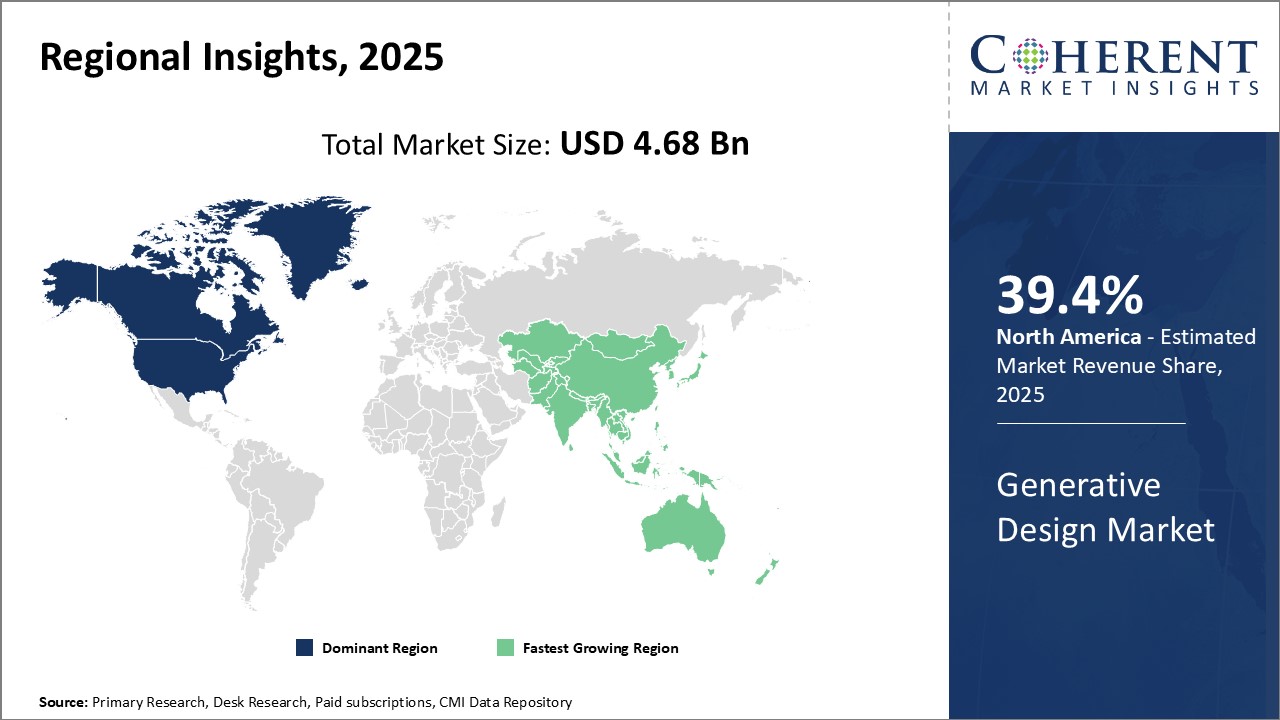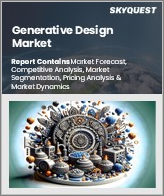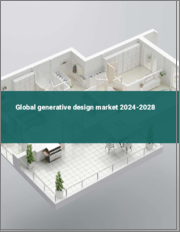
|
시장보고서
상품코드
1674183
제너레이티브 디자인 시장 : 배포별, 업계별, 지역별Generative Design Market, By Deployment, By Vertical, By Geography |
||||||
세계의 제너레이티브 디자인 시장은 2025년에 46억 8,000만 달러로 추정되며, 2032년에는 136억 5,000만 달러에 달할 것으로 예측되며, 2025-2032년에 16.5%의 CAGR(연평균 성장률)로 성장할 것으로 예측됩니다.
| 보고서 범위 | 보고서 상세 내용 | ||
|---|---|---|---|
| 기준연도 | 2024년 | 2025년 시장 규모 | 46억 8,000만 달러 |
| 실적 데이터 | 2020-2024년 | 예측 기간 | 2025-2032년 |
| 예측 기간 : 2025-2032년 CAGR | 16.50% | 2032년 금액 예측 | 136억 5,000만 달러 |

제너레이티브 디자인은 인공지능과 계산 설계 기술을 사용하여 새로운 설계 개념을 생성하고 성능을 최적화하는 새로운 설계 기법입니다. 엔지니어링 계산과 시뮬레이션을 자동화함으로써 설계자는 수천 개의 설계 반복을 몇 분 안에 검토할 수 있습니다. 제너레이티브 디자인은 자동화를 통해 설계 공간을 지능적으로 탐색하여 더 나은 설계를 더 빨리 찾을 수 있도록 합니다. 이 기술은 설계 탐색 및 반복 능력을 몇 배나 향상시켜 제품 설계 및 개발을 혁신할 수 있는 잠재력을 가지고 있습니다.
시장 역학
세계의 제너레이티브 디자인 시장 개발은 제품 개발 주기 단축에 대한 요구가 주도하고 있습니다. 제너레이티브 디자인은 복잡한 시뮬레이션과 계산을 내부적으로 처리함으로써 설계 반복에 소요되는 시간을 크게 단축하고 최적의 솔루션을 도출합니다. 이를 통해 설계자는 주어진 시간 내에 더 많은 설계 옵션을 이해할 수 있습니다. 또한 산업 전반에 걸쳐 3D 프린팅 및 AI와 같은 첨단 기술의 채택이 증가함에 따라 제너레이티브 디자인 소프트웨어에 대한 수요도 증가하고 있습니다. 그러나 제너레이티브 디자인 솔루션의 도입에는 높은 초기 비용과 숙련된 전문가 부족이 주요 과제로 남아있습니다. 설계 및 엔지니어링 부문의 R&D 투자 확대는 새로운 기회를 제공합니다.
본 조사의 주요 특징
세계의 제너레이티브 디자인(Generative Design) 시장에 대해 조사 분석했으며, 2024년을 기준 연도로 하여 예측 기간(2025-2032년) 시장 규모와 연평균 성장률(CAGR)을 게재하고 있습니다.
또한 다양한 부문에 걸친 잠재적 매출 기회를 밝히고, 이 시장의 매력적인 투자 제안 매트릭스를 설명합니다.
또한 시장 성장 촉진요인, 억제요인, 기회, 신제품 출시 및 승인, 시장 동향, 지역별 전망, 주요 기업의 경쟁 전략 등에 대한 주요 인사이트를 제공합니다.
이 보고서는 기업 하이라이트, 제품 포트폴리오, 주요 하이라이트, 재무 성과, 전략 등의 매개 변수를 기반으로 세계 제너레이티브 디자인 시장의 주요 기업을 프로파일링합니다.
본 조사의 대상이 되는 주요 기업에는 Adobe Inc., Altair Engineering Inc., ANSYS Inc., Autodesk Inc., Bentley Systems Inc., Dassault Systemes, Desktop Metal Inc., ESI Group, Google LLC, IBM Corporation, Microsoft Corporation, MSC Software, NVIDIA Corporation, Paramatters, Siemens AG 등이 포함됩니다.
이 보고서의 인사이트를 통해 마케팅 담당자와 기업 경영진은 향후 제품 출시, 유형화, 시장 확대, 마케팅 전술에 대한 정보에 입각한 의사결정을 내릴 수 있습니다.
세계 제너레이티브 디자인 시장 보고서는 투자자, 공급업체, 제품 제조업체, 유통업체, 신규 시장 진출기업, 재무 분석가 등 이 산업의 다양한 이해관계자를 대상으로 합니다.
이해관계자들은 세계 제너레이티브 디자인 시장 분석에 사용되는 다양한 전략 매트릭스를 통해 의사결정을 쉽게 내릴 수 있습니다.
목차
제1장 조사의 목적과 전제조건
- 조사 목적
- 전제조건
- 약어
제2장 시장 전망
- 리포트 설명
- 시장의 정의와 범위
- 개요
제3장 시장 역학, 규제, 동향 분석
- 시장 역학
- 촉진요인
- 억제요인
- 시장 기회
- 규제 시나리오
- 산업 동향
- 합병과 인수
- 신시스템 출시/승인
- COVID-19 팬데믹의 영향
제4장 세계의 제너레이티브 디자인 시장, 배포별, 2020-2032년
- 서론
- 클라우드 기반
- 온프레미스
제5장 세계의 제너레이티브 디자인 시장, 업계별, 2020-2032년
- 서론
- 자동차
- 항공우주와 방위
- 건축과 건설
- 산업 제조
- 기타
제6장 세계의 제너레이티브 디자인 시장, 지역별, 2020-2032년
- 서론
- 북미
- 유럽
- 아시아태평양
- 라틴아메리카
- 중동 및 아프리카
제7장 경쟁 구도
- 기업 개요
- Adobe Inc.
- Altair Engineering Inc.
- ANSYS Inc.
- Autodesk Inc.
- Bentley Systems Inc.
- Dassault Systemes
- Desktop Metal Inc.
- ESI Group
- Google LLC
- IBM Corporation
- Microsoft Corporation
- MSC Software
- NVIDIA Corporation
- Paramatters
- Siemens AG
제8장 애널리스트의 권장사항
- 운명의 수레바퀴
- COM(Coherent Opportunity Map)
제9장 참고 문헌과 조사 방법
- 참고 문헌
- 조사 방법
Global Generative Design Market is estimated to be valued at USD 4.68 Bn in 2025 and is expected to reach USD 13.65 Bn by 2032, growing at a compound annual growth rate (CAGR) of 16.5% from 2025 to 2032.
| Report Coverage | Report Details | ||
|---|---|---|---|
| Base Year: | 2024 | Market Size in 2025: | USD 4.68 Bn |
| Historical Data for: | 2020 To 2024 | Forecast Period: | 2025 To 2032 |
| Forecast Period 2025 to 2032 CAGR: | 16.50% | 2032 Value Projection: | USD 13.65 Bn |

Generative design is an emerging design methodology that uses artificial intelligence and computational design techniques to generate new design concepts and optimize performances. It allows designers to explore thousands of design iterations within minutes by automating engineering calculations and simulations. Generative design enables finding better designs faster by intelligently navigating the design space through automation. The technology has potential to transform product design and development by enhancing design exploration and iteration capabilities multifold.
Market Dynamics:
The global generative design market growth is driven by the need for faster product development cycles. Generative design significantly reduces the time taken to iterate designs and arrive at optimal solutions by handling complex simulations and calculations internally. This helps designers comprehend greater number of design options in a given timeframe. Additionally, rising adoption of advanced technologies like 3D printing and AI across industries is fueling demand for generative design software. However, high upfront costs of implementing generative design solutions and lack of skilled professionals remain key challenges. Nevertheless, growing R&D investments in design and engineering departments open new opportunities.
Key features of the study:
This report provides in-depth analysis of the global generative design market, and provides market size (US$ Bn) and compound annual growth rate (CAGR%) for the forecast period (2025-2032), considering 2024 as the base year
It elucidates potential revenue opportunities across different segments and explains attractive investment proposition matrices for this market
This study also provides key insights about market drivers, restraints, opportunities, new product launches or approval, market trends, regional outlook, and competitive strategies adopted by key players
It profiles key players in the global generative design market based on the following parameters - company highlights, products portfolio, key highlights, financial performance, and strategies
Key companies covered as a part of this study include Adobe Inc., Altair Engineering Inc., ANSYS Inc., Autodesk Inc., Bentley Systems Inc., Dassault Systemes, Desktop Metal Inc., ESI Group, Google LLC, IBM Corporation, Microsoft Corporation, MSC Software, NVIDIA Corporation, Paramatters, and Siemens AG
Insights from this report would allow marketers and the management authorities of the companies to make informed decisions regarding their future product launches, type up-gradation, market expansion, and marketing tactics
The global generative design market report caters to various stakeholders in this industry including investors, suppliers, product manufacturers, distributors, new entrants, and financial analysts
Stakeholders would have ease in decision-making through various strategy matrices used in analyzing the global generative design market.
Detailed Segmentation:
- By Deployment
- Cloud-based
- On-premises
- By Vertical
- Automotive
- Aerospace and Defense
- Architecture and Construction
- Industrial Manufacturing
- Others
- By Region
- North America
- Europe
- Asia Pacific
- Latin America
- Middle East & Africa
- Key Players Insights
- Adobe Inc.
- Altair Engineering Inc.
- ANSYS Inc.
- Autodesk Inc.
- Bentley Systems Inc.
- Dassault Systemes
- Desktop Metal Inc.
- ESI Group
- Google LLC
- IBM Corporation
- Microsoft Corporation
- MSC Software
- NVIDIA Corporation
- Paramatters
- Siemens AG
Table of Contents
1. Research Objectives and Assumptions
- Research Objectives
- Assumptions
- Abbreviations
2. Market Purview
- Report Description
- Market Definition and Scope
- Executive Summary
- Market Snippet, By Deployment
- Market Snippet, By Vertical
- Market Snippet, By Region
3. Market Dynamics, Regulations, and Trends Analysis
- Market Dynamics
- Drivers
- Restraints
- Market Opportunities
- Regulatory Scenario
- Industry Trend
- Merger and Acquisitions
- New System Launches/Approvals
- Impact of COVID-19 Pandemic
4. Global Generative Design Market, By Deployment, 2020-2032 (US$ Bn)
- Introduction
- Market Share Analysis, 2025 and 2032 (%)
- Y-o-Y Growth Analysis, 2020-2032
- Segment Trends
- Cloud-based
- Introduction
- Market Size and Forecast, 2020-2032, (US$ Bn)
- On-premises
- Introduction
- Market Size and Forecast, 2020-2032, (US$ Bn)
5. Global Generative Design Market, By Vertical, 2020-2032 (US$ Bn)
- Introduction
- Market Share Analysis, 2025 and 2032 (%)
- Y-o-Y Growth Analysis, 2020-2032
- Segment Trends
- Automotive
- Introduction
- Market Size and Forecast, 2020-2032, (US$ Bn)
- Aerospace and Defense
- Introduction
- Market Size and Forecast, 2020-2032, (US$ Bn)
- Architecture and Construction
- Introduction
- Market Size and Forecast, 2020-2032, (US$ Bn)
- Industrial Manufacturing
- Introduction
- Market Size and Forecast, 2020-2032, (US$ Bn)
- Others
- Introduction
- Market Size and Forecast, 2020-2032, (US$ Bn)
6. Global Generative Design Market, By Region, 2020-2032 (US$ Bn)
- Introduction
- Market Share Analysis, By Region, 2025 and 2032 (%)
- North America
- Regional Trends
- Market Size and Forecast, By Deployment, 2020-2032 (US$ Bn)
- Market Size and Forecast, By Vertical, 2020-2032 (US$ Bn)
- Market Share Analysis, By Country, 2025 and 2032 (%)
- U.S.
- Canada
- Europe
- Regional Trends
- Market Size and Forecast, By Deployment, 2020-2032 (US$ Bn)
- Market Size and Forecast, By Vertical, 2020-2032 (US$ Bn)
- Market Share Analysis, By Country, 2025 and 2032 (%)
- U.K.
- Germany
- France
- Russia
- Rest of Europe
- Asia Pacific
- Regional Trends
- Market Size and Forecast, By Deployment, 2020-2032 (US$ Bn)
- Market Size and Forecast, By Vertical, 2020-2032 (US$ Bn)
- Market Share Analysis, By Country, 2025 and 2032 (%)
- China
- India
- Japan
- ASEAN
- Australia
- South Korea
- Rest of Asia Pacific
- Latin America
- Regional Trends
- Market Size and Forecast, By Deployment, 2020-2032 (US$ Bn)
- Market Size and Forecast, By Vertical, 2020-2032 (US$ Bn)
- Market Share Analysis, By Country, 2025 and 2032 (%)
- Brazil
- Argentina
- Mexico
- Rest of Latin America
- Middle East & Africa
- Regional Trends
- Market Size and Forecast, By Deployment, 2020-2032 (US$ Bn)
- Market Size and Forecast, By Vertical, 2020-2032 (US$ Bn)
- Market Share Analysis, By Country, 2025 and 2032 (%)
- South Africa
- GCC Countries
- Rest of the Middle East & Africa
7. Competitive Landscape
- Company Profiles
- Adobe Inc.
- Company Overview
- Product Portfolio
- Financial Performance
- Key Strategies
- Recent Developments/Updates
- Altair Engineering Inc.
- Company Overview
- Product Portfolio
- Financial Performance
- Key Strategies
- Recent Developments/Updates
- ANSYS Inc.
- Company Overview
- Product Portfolio
- Financial Performance
- Key Strategies
- Recent Developments/Updates
- Autodesk Inc.
- Company Overview
- Product Portfolio
- Financial Performance
- Key Strategies
- Recent Developments/Updates
- Bentley Systems Inc.
- Company Overview
- Product Portfolio
- Financial Performance
- Key Strategies
- Recent Developments/Updates
- Dassault Systemes
- Company Overview
- Product Portfolio
- Financial Performance
- Key Strategies
- Recent Developments/Updates
- Desktop Metal Inc.
- Company Overview
- Product Portfolio
- Financial Performance
- Key Strategies
- Recent Developments/Updates
- ESI Group
- Company Overview
- Product Portfolio
- Financial Performance
- Key Strategies
- Recent Developments/Updates
- Google LLC
- Company Overview
- Product Portfolio
- Financial Performance
- Key Strategies
- Recent Developments/Updates
- IBM Corporation
- Company Overview
- Product Portfolio
- Financial Performance
- Key Strategies
- Recent Developments/Updates
- Microsoft Corporation
- Company Overview
- Product Portfolio
- Financial Performance
- Key Strategies
- Recent Developments/Updates
- MSC Software
- Company Overview
- Product Portfolio
- Financial Performance
- Key Strategies
- Recent Developments/Updates
- NVIDIA Corporation
- Company Overview
- Product Portfolio
- Financial Performance
- Key Strategies
- Recent Developments/Updates
- Paramatters
- Company Overview
- Product Portfolio
- Financial Performance
- Key Strategies
- Recent Developments/Updates
- Siemens AG
- Company Overview
- Product Portfolio
- Financial Performance
- Key Strategies
- Recent Developments/Updates
- Adobe Inc.
8. Analyst Recommendation
- Wheel of Fortune
- Analyst View
- Coherent Opportunity Map
9. Reference and Research Methodology
- References
- Research Methodology
- About us and Sales Contact



















